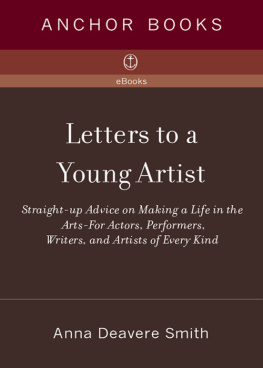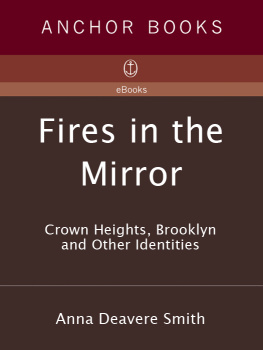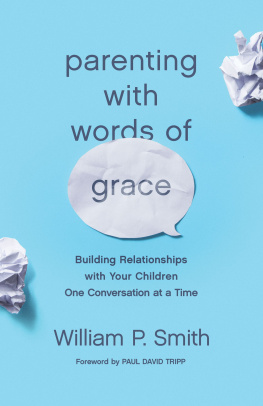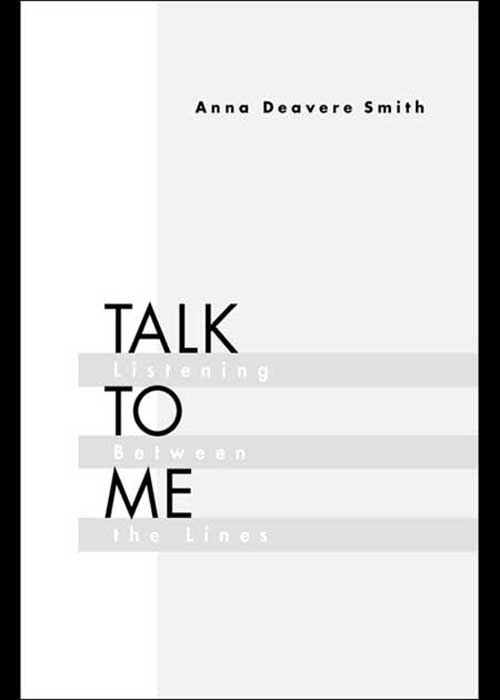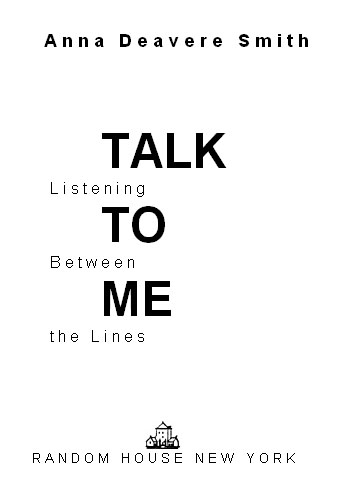Anna Deavere Smith - Talk to Me: Listening Between the Lines
Here you can read online Anna Deavere Smith - Talk to Me: Listening Between the Lines full text of the book (entire story) in english for free. Download pdf and epub, get meaning, cover and reviews about this ebook. year: 2001, publisher: Random House Publishing Group, genre: Detective and thriller. Description of the work, (preface) as well as reviews are available. Best literature library LitArk.com created for fans of good reading and offers a wide selection of genres:
Romance novel
Science fiction
Adventure
Detective
Science
History
Home and family
Prose
Art
Politics
Computer
Non-fiction
Religion
Business
Children
Humor
Choose a favorite category and find really read worthwhile books. Enjoy immersion in the world of imagination, feel the emotions of the characters or learn something new for yourself, make an fascinating discovery.

- Book:Talk to Me: Listening Between the Lines
- Author:
- Publisher:Random House Publishing Group
- Genre:
- Year:2001
- Rating:4 / 5
- Favourites:Add to favourites
- Your mark:
Talk to Me: Listening Between the Lines: summary, description and annotation
We offer to read an annotation, description, summary or preface (depends on what the author of the book "Talk to Me: Listening Between the Lines" wrote himself). If you haven't found the necessary information about the book — write in the comments, we will try to find it.
The conductors voice had a mild kind of grandeur that was a cousin to the vocal tones I had heard at funeralsAshes-to-ashesand at christenings and weddings. These are words that have been said many times, but the person who speaks them understands that each time it must be said as if it matters, because it does matter. We never know what lies ahead, and we never know what just happened, and all words must house respect of those two unknowns.
In Talk to Me, Smith looks back at a singular career as a seeker and interpreter of language in America, revealing the methodology behind her extraordinary search for the truth and nuances of verbal communication. For thirty years, the defining thesis of Smiths work has been that how we speak is just as important in communicating truth and identity as what we say. Everything from individual vocal tone to grammar, Smith demonstrates, can be as identifiable and revealing as a fingerprint. Her journey has taken her from the rarefied bastions of academia to riot-torn streets; she has conducted hundreds of interviews with subjects ranging from women prisoners to presidents of the United States. In 1995, her ongoing investigation led her to Washington, D.C. After all, what better place to wage an inquiry into the power of language and the language of power than in the city where message is a manufactured product? What happens when we as citizens acceptwhich we seem to be doing more and moreour chosen leaders failure to tell the truth? And how can we know that we are hearing what Washington really has to say when everything we receive is filtered through the media?
Armed with a blazing intellect and a tape recorder, Smith tackled these questions head-on, conducting more than four hundred interviews with people both inside and outside the power structure of Washington. She recorded these sessions in her trademark verbatim transcripts, which include every tic and verbal utterance of her subjects. More than thirty of these remarkable documents appear in this book, including interviews with Bill Clinton, Anita Hill, Studs Terkel, George Bush, Mike McCurry, and Helen Thomas. After five years of searing investigation into the world of the politicians, spin doctors, and power brokers who are steering the course of our country from inside the beltway, Smith has come away with a revelatory assessmentby turns devastating and hopefulof the lexicon of power and politics in America. Talk to Me is a landmark contribution from a woman whose pioneering insights into language speak volumes.
Anna Deavere Smith: author's other books
Who wrote Talk to Me: Listening Between the Lines? Find out the surname, the name of the author of the book and a list of all author's works by series.

